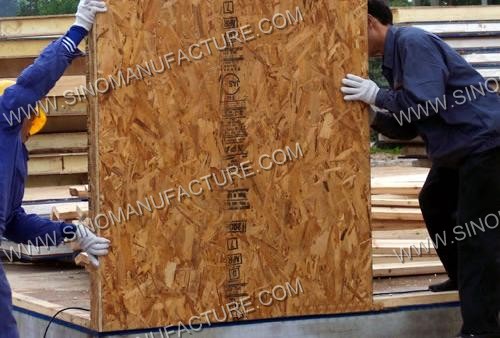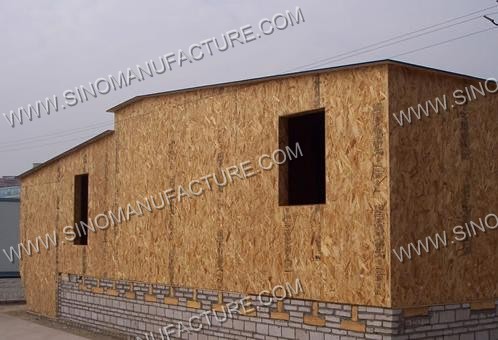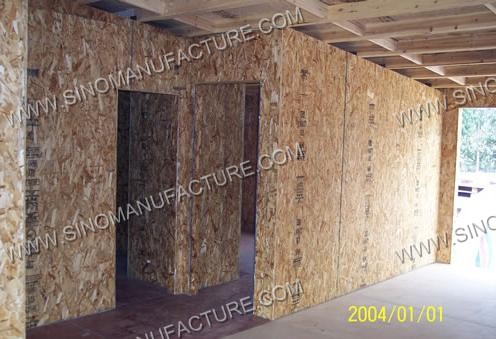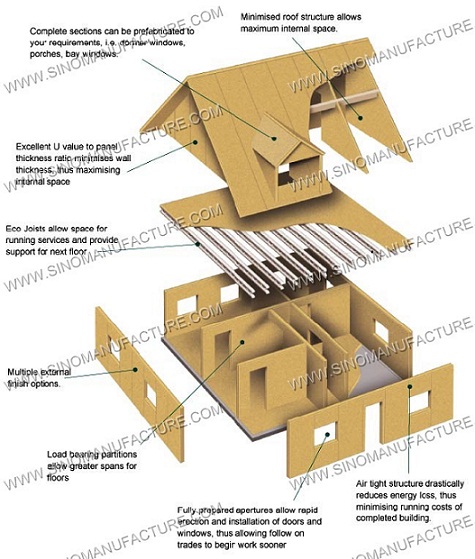SINO GROUP |
INTRODUCTION - Structural Insulated Panel
SIPs is a kind of high performance architectural wall material, OSB
boards or waterproof plywood on both sides of the panel, high
density PU foam as the core. It's widely used as wall, floor or
roof of residential and commercial buildings in Occident countries.
It becomes a rising trend of construction. In 2002, the SIPS
manufacturers from North American and the Pacific Rim, over 80
countries or regions got together, discuss the requirement of
costumers also the development of this industry. Nowadays,
International SIPs organization "SIPA" has already been
established, the application and popularization of SIPs have been
widespread, which is going to be the fashionable trend of
residence, commercial building, mobile houses construction.
There is no need of frameworks in SIPs house and the constructing
speed is rapid, it also has a good heat preservation.
Product standard: 4'×8'/12'/16'
Product thickness: 50/75/100MM
Applications: Wall, Floor, Roof, etc.

SIP production line
Our company provides all services for development of
wood-frame construction, such as:
Standard Production Line
Standard Line is capable to produce 400-500 sq m of SIPs in 8 hrs shift. Equipment is not fully automated and needs labor to be involved. All operations are covered by 5 persons. Standard line consists of two main components – vacuum (or hydraulic) press and glue applicator. Production process requires some additional equipment such as air system for pneumatic tools and forklift for handling of panels. Due to very low energy consumption, production costs are minimal. Installation and start up of standard line requires 3 days.
Structural insulated panels (SIPs) are typically made by sandwiching a core of rigid foam plastic insulation (10-20 cm thick) between two structural skins of oriented strand board (OSB) reinforced with inserted beams. SIPs share the same structural properties as an I-beam or I-column. The rigid insulation core of the SIP performs as a web, while the OSB sheathing exhibits the same properties as the flanges. SIPs replace several components of conventional building such as studs and joists, insulation, vapor barrier and air barrier. The thickness of ready panel varies from 11 to 25 cm depending on it's purpose. Dimensions of ready panels also differ within a maximum of 2.4 x 7.0 m. As such they can be used for many different applications such as exterior wall, roof, floor and foundation systems.
Assembling of panels and further house construction does not necessarily require heavy lifting machinery, as panels are light (18-20 kg of 1 sq m of panel), and also there is no need for qualified labor – one specialist supervises and manages manufacturing and assembling of houses.
SIP homes require no special heating system. Forced air, electric, solar, radiant and wood burning systems are all suitable, though some are more appropriate than others for a specific home design. Walls constructed of SIPs typically provide superior insulating qualities. SIPs also inherently have significantly less air infiltration (if properly installed). The solid foam cores in correctly installed SIPs create a tight building envelope.
Electrical wiring is typically run in the conventionally framed interior walls, but there will be some wiring in the exterior panels. SIP wall panels are typically manufactured with a wire chase at specified height above the sub floor. Wire chases can also be located at counter height for kitchen outlets. Vertical chases can be provided, but are often not needed because the wire can be run along a door opening or through interior wall framing. Plumbing is not normally run through foam core panels.





Technical data
| № | Description | Unit | Value |
| 1 | SIP dimensions (max) | mm | 2400х7000 |
| 2 | SIP thickness (max) | mm | 900 |
| 3 | OSB thickness | mm | 10-14 |
| 4 | Time required for gluing of panels | min | 60-90 |
| 5 | Pressure required for gluing | atm | 0,8 |
| 6 | Total power consumption of electric motors
| KVA KVA |
1,43 |
| 7 | Output (max) of panels | m2 / shift | 400-450 |
| 8 | Production Line dimensions | mm | 12000х3500 |
| 9 | Weight of equipment | kg | 2700 |
Space requirements
Power requirements
Electricity (110 or 220 V, 380 V)
Other requirements
Compressed air, water Electricity (110 or 220 V, 380 V)
Environment protection
- Energy efficiency
Structural insulated panels are one of the most environmentally responsible building systems available. A SIP building envelope provides high levels of insulation and is extremely airtight, meaning the amount of energy used to heat and cool a home can be cut by up to 50 percent. The energy that powers homes and commercial buildings is responsible for a large portion of greenhouse gasses emitted into the atmosphere. By reducing the amount of energy used in buildings, architects, builders, and homeowners can contribute to a clean environment for the future.
- Resource use
The insulation used in SIPs is a lightweight rigid foam plastic composed of 98% air, and requires only a small amount of petroleum to produce. The foam insulation used in panel cores is made using a non-CFC blowing agent that does not threaten the earth’s ozone layer.
- Waste minimization
Since SIPs are prefabricated in the factory, there is less jobsite waste that needs to be landfilled. Factory fabrication is often done using optimization software and many manufacturers recycle factory scrap to make other foam products.
 | ||
